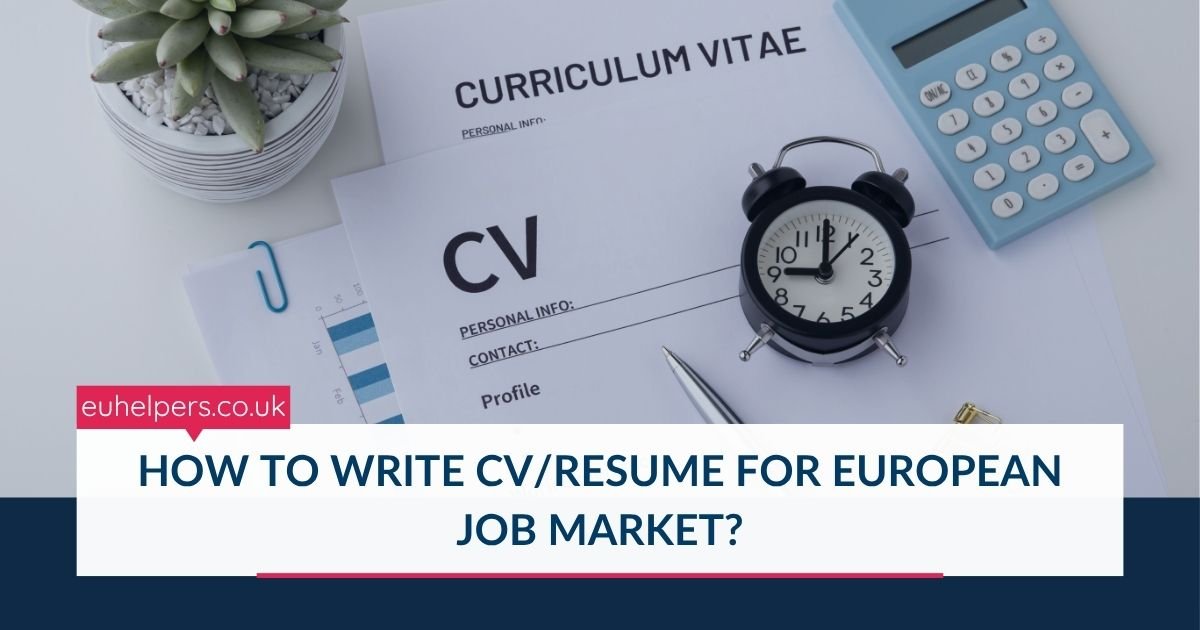
Looking to work in Europe? One of the first steps to success is writing a CV that meets European standards. While many countries use the term “CV” (Curriculum Vitae) instead of “resume,” the goal is the same — to clearly present your skills, qualifications, and experience in a professional, concise, and localized way.
This guide explains exactly how to write a Europe-ready CV that can help you stand out to employers and visa authorities.
1. Understand the European CV Format
In Europe, the CV format is different from American or Asian resumes. It focuses on clarity, consistency, and relevant details.
Typical structure:
-
Personal Information
-
Professional Summary
-
Work Experience
-
Education
-
Skills & Languages
-
Certifications or Additional Information
Tip: In most European countries, two pages is acceptable. Keep it concise and relevant.
2. Use the Europass Format (Optional but Popular)
The Europass CV is an EU-standardized format designed to make qualifications easily understood across countries.
You can create it online at europa.eu/europass.
Why use it:
-
Recognized by European employers and embassies
-
Free and easy to generate
-
Compatible with different EU job portals
However, for private companies or modern job roles, a custom professional CV in PDF format is often preferred.
3. Include Complete Personal Details
At the top of your CV, include:
-
Full name
-
Nationality
-
Phone number (with country code)
-
Email address (professional only)
-
City and country of residence
-
LinkedIn profile (if available)
Should you add a photo?
In most European countries (like Germany, Czech Republic, or Poland), a passport-style photo is acceptable.
However, in the UK, Ireland, and the Netherlands, it’s better not to include a photo to avoid bias.
4. Write a Short Professional Summary
This section should be 2–4 sentences describing who you are, your expertise, and what you’re looking for.
Example:
“Experienced mechanical technician with 5+ years of factory maintenance experience in Europe. Skilled in CNC operations, welding, and production supervision. Seeking long-term employment with a certified European company.”
Keep it factual — avoid overused words like “hardworking” or “motivated.”
5. Present Work Experience Clearly
List your most recent job first.
Include:
-
Job Title
-
Company Name & Location
-
Duration (Month/Year – Month/Year)
-
Main Responsibilities & Achievements
Example:
Machine Operator – ABC Manufacturing, Poland
Jan 2021 – Present
Operate and maintain packaging lines.
Train new staff and ensure quality compliance.
Reduced downtime by 12% through improved maintenance schedule.
6. Highlight Education and Training
Start with your highest qualification.
Include degree name, institution, country, and completion year.
Tip: If your qualifications were obtained outside the EU, mention recognized equivalence or diploma translation if applicable.
7. Emphasize Skills and Languages
Key skills: List job-specific technical and soft skills such as:
-
Forklift operation
-
MIG/TIG welding
-
Inventory management
-
Basic computer literacy
Languages:
Mention your language proficiency levels — use CEFR standards (A1–C2).
Example:
-
English – B2 (Upper-Intermediate)
-
Polish – A2 (Basic)
8. Add Certifications and Courses
European employers appreciate verified training and certifications.
Add short details like:
-
Safety Training (OSHA/NEBOSH)
-
Forklift License
-
Welding Certificate EN ISO 9606
9. Format Professionally for Readability
- Use clear section headings (Work Experience, Education, Skills).
- Stick to professional fonts (Arial, Calibri, Roboto).
- Maintain consistent alignment and spacing.
- Save and send as PDF format (never Word files).
- Keep total length 1–2 pages max.
10. Tailor Your CV for Each European Country
Different European countries value different elements:
-
Germany: Detailed technical roles, references, and photo
-
Poland: Clear structure + focus on experience
-
Netherlands: Short, skill-oriented CVs
-
France: Include brief motivation and diplomas
-
UK/Ireland: No photo, focus on achievements
Research before applying — a country-adapted CV increases your chances dramatically.
Bonus Tip: Add a Consent Statement (Poland & EU Requirement)
In Poland and several EU countries, you must include this data-protection clause at the end of your CV:
“I hereby give consent for my personal data included in my application to be processed for the purposes of recruitment under the Personal Data Protection Act in accordance with Regulation (EU) 2016/679.”
This ensures legal compliance for employers reviewing your CV.
Common Mistakes to Avoid
- Using the same CV for all countries
- Missing dates or incomplete contact info
- Adding personal details (religion, marital status, etc.)
- Sending without proofreading or translation check
Key Takeaways
- Keep your CV short, structured, and tailored
- Use the Europass format or a clean custom design
- Focus on relevant experience and measurable achievements
- Add language skills and consent statement if needed
- Always save and send your CV as a PDF file
Disclaimer
This article is for informational purposes only. CV expectations vary by country and employer. Always confirm local HR norms or embassy requirements before submitting applications.
FAQs
1. Is a photo mandatory on a European CV?
No. It’s optional and country-dependent — common in Central Europe, not in the UK or Ireland.
2. Should I use Europass or a custom CV?
Both are accepted. Europass is ideal for visa/official applications, while custom CVs work best for private employers.
3. How long should a European CV be?
Ideally 1–2 pages, depending on experience.
4. Can I send the same CV for multiple countries?
It’s better to adapt it slightly to each country’s format and language preferences.
5. Do I need to translate my CV?
Yes, if applying to non-English-speaking countries like Poland, Czech Republic, or France. English CVs are fine for international companies.
